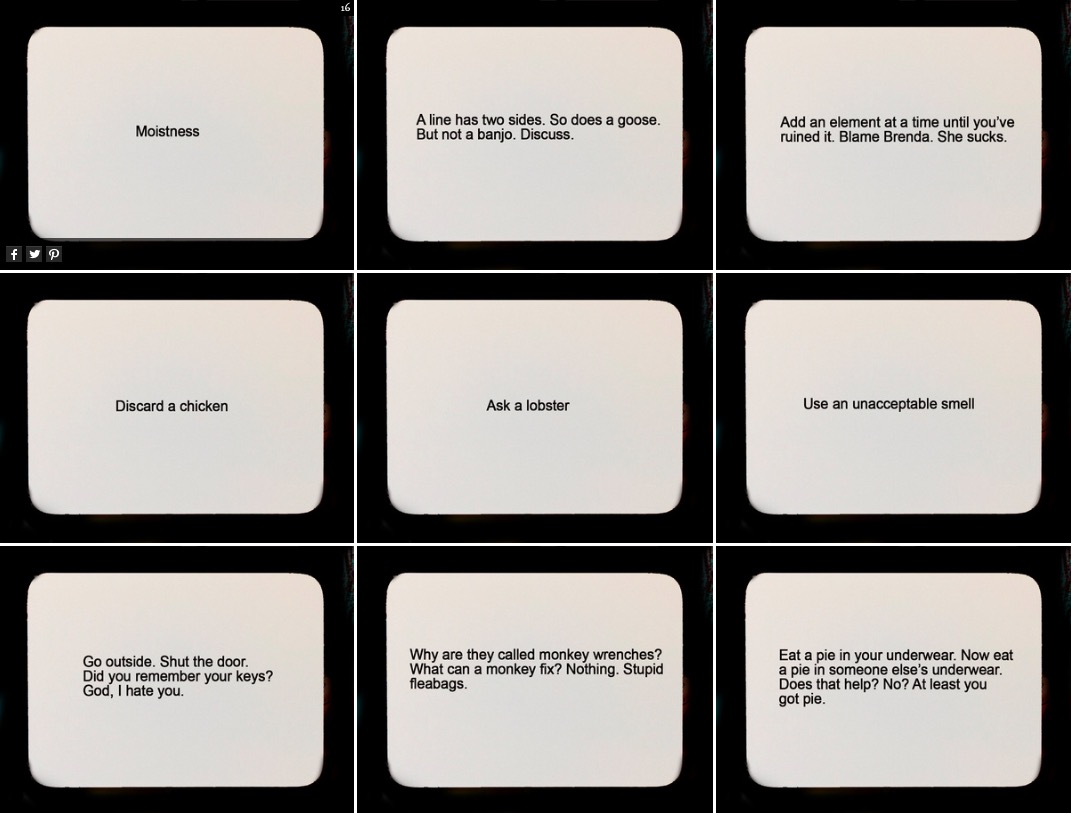Over one-hundred worthwhile dilemmas by Briano Eno and Peter Schmidt. In 1975, Peter Schmidt and Brian Eno created the original pack of Oblique Strategies cards, through thinking about approaches to their own work as artist and musician. The Oblique Strategies constitute a set of over 100 cards, each of which is a suggestion of a course of action or thinking to assist in creative situations. These famous cards have been used by many artists.
Brian Eno’s Oblique Strategies – the Ultimate Music Production Tool April 29, 2009 By Ian Shepherd Forget computers and plugins, forget pop shields, forget the SwirlyGig, forget SSL desks and tantric breathing exercises – forget all that stuff, and open your mind to a real music production tool – the Oblique Strategies. Short circuit (example: a man eating peas with the idea that they will improve his virility shovels them straight into his lap).
The Oblique Strategies are a deck of cards. Up until 1996, they were quite easy to describe.They measured about 2-3/4'x 3-3/4'. They came in a small black box which said 'OBLIQUE STRATEGIES'on one of the top's long sides and 'BRIAN ENO/PETER SCHMIDT' onthe other side. The cards were solid black on one side, and had the aphorismsprinted in a 10-point sans serif face on the other.
That was then, and this is now. There is now another set of the ObliqueStrategies in existence, and it looks nothing like this; perhapsthe best way to think of the differences between the earlier versionsand the fourth edition deck is by analogy. Wherethe earlier versions were a quiet, well-dressed neighbor who, once you gotused to her/him, turned out to be a funny, intriguing, and frighteninglyprescient friend, the 1996 version is the equivalent of going to the otherapartment on your floor to ask directions to someplace and discovering a large, noisy party full of tipsy graduate students attempting some kind of fashionable dance en masse who pause only to give you advice in a half-dozenlanguages.
Brian Eno Oblique Strategies Online
But I digress. Perhaps it's best to attempt a description of their intention and function.
Oblique Strategies, originally presented as a pack of cards, were by Brian Eno and Peter Schmidt. Each Oblique Strategy is a phrase or cryptic remark which can be used to break a creative deadlock or dilemma situation. This website presents a random Oblique Strategy selected from editions 1–5. Website by Josh Harrison. It takes time and money.

The deck itself had its origins in the discovery by Brian Eno that bothhe and his friend Peter Schmidt (a British painter whose works grace thecover of 'Evening Star' and whose watercolours decorated the backLP cover of Eno's 'Before and After Science' and also appearedas full-size prints in a small number of the original releases)tended to keep a set of basic working principles which guided them throughthe kinds of moments of pressure - either working through a heavy paintingsession or watching the clock tick while you're running up a big buck studiobill. Both Schmidt and Eno realized that the pressures of time tended tosteer them away from the ways of thinking they found most productive whenthe pressure was off. The Strategies were, then, a way to remind themselvesof those habits of thinking - to jog the mind.
It is not clear from any sources I've run across whether the cards wereexplicitly intended to be oracular at the outset - that is, whether or notPeter Schmidt and Eno necessarily saw them exclusively as a 'singleinstruction/single response' kind of 'game'. The introductorycards included in all three versions of the first versions of the Oblique Strategies suggest otherwise.It seems clear, also, that the deck was not conceived of as a set of 'fixed'instructions, but rather a group of ideas to be added to or modified overtime; each of the three decks included 4 or 5 blank cards, intended to befilled and used as needed.

Eno discusses the Oblique Strategies at greatest length in an interviewwith Charles Amirkhanian, conducted at KPFA in Berkeley in early 1980:

'These cards evolved from our separate working procedures. It was one of the many cases during the friendship that he [Peter Schmidt] and I where we arrived at a working position at almost exactly the same time and almost in exactly the same words. There were times when we hadn't seen each other for a few months at a time sometimes, and upon remeeting or exchanging letters, we would find that we were in the same intellectual position - which was quite different from the one we'd been in prior to that.


The Oblique Strategies evolved from me being in a number of working situations when the panic of the situation - particularly in studios - tended to make me quickly forget that there were others ways of working and that there were tangential ways of attacking problems that were in many senses more interesting than the direct head-on approach. If you're in a panic, you tend to take the head-on approach because it seems to be the one that's going to yield the best results Of course, that often isn't the case - it's just the most obvious and - apparently - reliable method. The function of the Oblique Strategies was, initially, to serve as a series of prompts which said, 'Don't forget that you could adopt *this* attitude,' or 'Don't forget you could adopt *that* attitude.'
The first Oblique Strategy said 'Honour thy error as a hidden intention.' And, in fact, Peter's first Oblique Strategy - done quite independently and before either of us had become conscious that the other was doing that - was ...I think it was 'Was it really a mistake?' which was, of course, much the same kind of message. Well, I collected about fifteen or twenty of these and then I put them onto cards. At the same time, Peter had been keeping a little book of messages to himself as regards painting, and he'd kept those in a notebook. We were both very surprised to find the other not only using a similar system but also many of the messages being absolutely overlapping, you know...there was a complete correspondence between the messages. So subsequently we decided to try to work out a way of making that available to other people, which we did; we published them as a pack of cards, and they're now used by quite a lot of different people, I think.
-Brian Eno, interview with Charles Amirkhanian, KPFA-FM Berkeley, 2/1/80
An introduction to the Oblique Strategies can be found in the deck itself.This is how each of the first three decks labels and describes itself:
(card one)
OBLIQUE STRATEGIES
Over one hundred worthwhile dilemmas
by BRIAN ENO and PETER SCHMIDT
(signatures, if your copy is signed)
Printed January 1975 in an edition of 500
of which this is number (your number, circled)
(note: later versions note that the deck has been revised, and includethe date of publication - either 1978 for edition two, or 1979 for editionthree)
(card two)
Brian Eno Oblique Strategies Cards Pdf
These cards evolved from our separate observations on the principlesunderlying what we were doing. Sometimes they were recognized in retrospect(intellect catching up with intuition), sometimes they were identified asthey were happening, sometimes they were formulated.
Brian Eno Oblique Strategies Generator
They can be used as a pack (a set of possibilities being continuouslyreviewed in the mind) or by drawing a single card from the shuffled packwhen a dilemma occurs in a working situation. In this case,the card is trustedeven if its appropriateness is quite unclear. They are not final, as newideas will present themselves, and others will become self-evident.